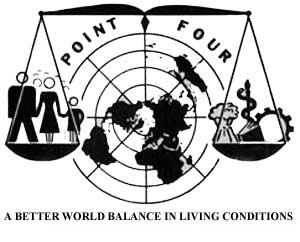
Background
On a frosty January 20th, 1949, after a dramatic re-election campaign, President Harry S. Truman delivered his Second Inaugural Address. In this speech, Truman described his foreign policy goals in four direct points. The fourth point, which has become known as the Point Four Program, took the country by surprise. This fourth point declared that the United States would “embark on a bold new program for making the benefits of our scientific advances and industrial progress available for the improvement and growth of underdeveloped areas.”
Truman’s Point Four proposal, along with the much larger Marshall Plan, would not be a totally new idea. What was new was how Truman made a connection between foreign aid and freedom.
- Greater production is the key to prosperity and peace. And the key to greater production is a wider and more vigorous application of modern scientific and technical knowledge.
- Only by helping the least fortunate of its members to help themselves can the human family achieve the decent, satisfying life that is the right of all people.
- Democracy alone can supply the vitalizing force to stir the peoples of the world into triumphant action, not only against their human oppressors, but also against their ancient enemies-hunger, misery, and despair.
- On the basis of these four major courses of action we hope to help create the conditions that will lead eventually to personal freedom and happiness for all mankind.
In 1949 the need for American aid in the world was great. European and Asian nations were still recovering from the destruction left behind by WWII. Other areas in the Middle East, Africa, and Asia were gaining their independence after centuries of control by European countries. Harry Truman knew that when people struggle and suffer they are more likely to be dominated by stronger powers. He also knew that United States was the only country in the world in a position to help.
Everyone in the audience understood the context of Truman’s speech. In 1949 the United States was locked in a competition with the Soviet Union for influence in the world. When Harry spoke of oppressors, he was talking about that country’s efforts to spread communism. Since WWII the United States had been unable to stop the Soviet Union from dominating Eastern Europe. Americans were afraid that other struggling countries would experience a similar fate.
One way Truman hoped to combat this threat was to aid the underdeveloped parts of the world. This aid would come, not in the form of money, but by spreading knowledge and expertise. Instead of giving food, the US would help develop farms. “More food, more clothing, more materials for housing, and more mechanical power…” Helping countries take care of themselves, it was felt, would be the best way to ensure they find “prosperity and peace”.
While the idea was instantly popular, it turned out that providing international aid is a tricky business. Agencies created by Congress sent technicians to countries around the world to work on specific projects. Unfortunately, by 1952, officials were still hoping to have a few pilot programs in place to highlight the potential impact of Truman’s proposal. Today, decades later, 1.3 billion people live in extreme poverty. The world still struggles with ways to make a difference in these people’s lives.
Key Question
Why is providing International Aid harder than it sounds?
Materials
Documents to be examined:
- Point IV Report Supplemental Resources
- Telegram, Charles F. Boss to Harry Truman, July 24, 1950
- Draft of Address of the President to the National Conference on International Economic and Social Development, April 8, 1952
- Oral History Interview with Samuel P. Hayes, July 16, 1975
- Oral History Interview with Stanley Andrews, October 31, 1970
- Letter to President Truman from the Department of Agriculture, April 11, 1951
- Outline of Remarks by Secretary of State Dean Acheson at the National Conference on International Economic and Social Development, April 9, 1952
- Summary of Remarks by Jonathan Bingham, November 12, 1952